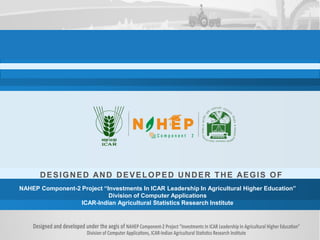
Cell biology for the under graduate course
- 1. DESIGNED AND DEVELOPED UNDER THE AEGIS OF NAHEP Component-2 Project “Investments In ICAR Leadership In Agricultural Higher Education” Division of Computer Applications ICAR-Indian Agricultural Statistics Research Institute
- 2. Course Details Course Name Cell Biology Lesson 1 Origin and evolution of cell Disclaimer : Presentations are intended for educational purposes only and do not replace independent professional judgement. Statement of fact and opinions expressed are those of the presenter individually and are not the opinion or position of ICAR-IASRI. ICAR-IASRI does not endorse or approve, and assumes no responsibility for the content, accuracy or completeness of the information presented.
- 3. Name Role University Tushar Ranjan Content Creator Bihar Agricultural University, Bhagalpur Dr. Shanthala J Course Reviewer Sher-e-Kashmir University of University of Agricultural Sciences, Bangalore Created by
- 4. Cells are divided into two main classes, initially defined by whether they contain a nucleus. Prokaryotic cells (bacteria) lack a nuclear envelope; eukaryotic cells have a nucleus in which the genetic material is separated from the cytoplasm. Prokaryotic cells are generally smaller and simpler than eukaryotic cells; in addition to the absence of a nucleus, their genomes are less complex and they do not contain cytoplasmic organelles or a cytoskeleton. In spite of these differences, the same basic molecular mechanisms govern the lives of both prokaryotes and eukaryotes, indicating that all present-day cells are descended from a single primordial ancestor. Characteristic Prokaryote Eukaryote Nucleus Absent Present Diameter of a typical cell ≈1μm 10–100 μm Cytoskeleton Absent Present Cytoplasmic organelles Absent Present DNA content (base pairs) 1×106 to 5×106 1.5×107 to 5×109 Chromosomes Single circular DNA molecule Multiple linear DNA molecules Background
- 5. Time Scale of Evolution Life first emerged at least 3.8 billion years ago, approximately 750 million years after Earth was formed. It was first suggested that simple organic molecules could form and spontaneously polymerize into macromolecules under the conditions thought to exist in primitive Earth's atmosphere.
- 6. The RNA World Of the two major classes of informational macromolecules in present-day cells (nucleic acids and proteins), only the nucleic acids are capable of directing their own self- replication. Nucleic acids can serve as templates for their own synthesis as a result of specific base pairing between complementary nucleotides. RNA is capable of catalyzing a number of chemical reactions, including the polymerization of nucleotides (Altman and Cech). RNA is generally believed to have been the initial genetic system, and an early stage of chemical evolution is thought to have been based on self-replicating RNA molecules.
- 7. Protection of Genetic Material Inside Lipid Bilayer Coat The first cell is presumed to have arisen by the enclosure of self-replicating RNA in a membrane composed of phospholipids. The key characteristic of the phospholipids that form membranes is that they are amphipathic molecules, meaning that one portion of the molecule is soluble in water and another portion is not. Phospholipids have long, water-insoluble (hydrophobic) hydrocarbon chains joined to water-soluble (hydrophilic) head groups that contain phosphate.
- 8. Endosymbiotic Theory: Evolution of Eukaryotic Cell The endosymbiotic theory states that some of the organelles in today's eukaryotic cells were once prokaryotic microbes. In this theory, the first eukaryotic cell was probably an amoeba-like cell that got nutrients by phagocytosis and contained a nucleus that formed when a piece of the cytoplasmic membrane pinched off around the chromosomes.
- 9. Evolution of Metabolic Pathways Because cells originated in a sea of organic molecules, they were able to obtain food and energy directly from their environment. But such a situation is self-limiting, so cells needed to evolve their own mechanisms for generating energy and synthesizing the molecules necessary for their replication. All cells use adenosine 5′-triphosphate (ATP) as their source of metabolic energy to drive the synthesis of cell constituents and carry out other energy-requiring activities, such as movement (e.g., muscle contraction). The mechanisms used by cells for the generation of ATP are thought to have evolved in three stages, corresponding to the evolution of glycolysis, photosynthesis, and oxidative metabolism. The development of these metabolic pathways changed Earth's atmosphere, thereby altering the course of further evolution.
- 10. Thank You
- 11. THANK YOU